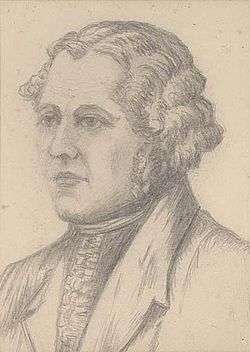William Booth (forger)
William Booth (1776–1812) was an English farmer and forger.[1] He is the subject of the song "Twice Tried, Twice Hung, Twice Buried" by John Raven.[2]
William Booth | |
|---|---|
 Pencil sketch of Booth, artist unknown | |
| Born | |
| Died | 12 August 1812 |
| Nationality | English |
| Occupation | Farmer |
| Conviction(s) | Forgery |
| Criminal penalty | Death by hanging |
Booth was born at Hall End Farm near Beaudesert, Warwickshire and was baptised at the church there on 21 February 1776.[3] He was one of eight children of a farmer and church warden, John Booth, and his wife Mary.[4] He lived at Great Barr, then in Staffordshire and now in the city of Birmingham.
On 28 February 1799, Booth signed a 25-year lease for what became known (by 1821 if not earlier)[5] as "Booth's Farm"[lower-alpha 1], including a farmhouse and 200 acres of land,[5] part of the Perry Hall[lower-alpha 2]estate.[5]
He was accused of murdering his brother John while revisiting Hall End on 19 February 1808, but was acquitted for lack of evidence.[4]
He converted the top floor of the farmhouse into a workshop where he produced forgeries of coins and banknotes.[1] He was caught, tried at Stafford Assizes[6] and sentenced to hang.[1] His accomplices were sentenced to transportation to Australia.[4]
Booth's execution on 12 August 1812 was bungled, and he fell through the scaffold's trap door to the floor.[4] Within two hours, he was hanged again and died.[2] He was one of the last people (if not the last) to be sentenced to death in England for forgery.[6]
He is buried in the churchyard of St Mary's, Handsworth[lower-alpha 3].[1] The inscription on his gravestone reads:[7][8]
Sacred to the memory of William Booth who departed this life August 12th 1812 aged 33 years. Also Charlotte daughter of William and Mary Booth who died August 13th 5 months.
Following a change of county boundary, his body was disinterred and reburied.[2]
A public outcry at the harshness of his sentence resulted in the death penalty in England and Wales being reserved for capital crimes, making Booth the last person in England hanged for a non-capital crime.[9]
Booth also minted genuine tokens as a cover for his forging activities.[10] Several of his tokens, forgeries and printing plates are in the collection of Birmingham Museum & Art Gallery.
The farmhouse was demolished in 1974,[5] and the farm - known as Booth's Farm - became a sand and gravel quarry (later landfill and a nature reserve), having given its name to the still-extant Booths Lane[lower-alpha 4] and Booths Farm Road[lower-alpha 5]. Until the late 1920s, it was occupied by the Foden Family,[5] commemorated in Foden Road[lower-alpha 6].
Coordinates
- Booth's Farm: 52.544°N 1.911°W (approximate location)
- Perry Hall: 52.52507°N 1.91084°W
- St Mary's Church: 52.51056°N 1.91917°W
- Booths Lane: 52.54405°N 1.90959°W
- Booths Farm Road: 52.54031°N 1.91951°W
- Foden Road: 52.53958°N 1.92093°W
References
- "Booth's Farm". Digital Handsworth. Birmingham City Council. Retrieved 8 November 2011.
- "Twice Tried, Twice Hung, Twice Buried". Retrieved 8 November 2011.
- Warwickshire, England, Church of England Baptisms, Marriages, and Burials, 1535-1812 William Booth, son of John and Mary Booth, Baptised 21 Feb 1776 in Beaudesert, Warwickshire, England
- Booth, John N. Booths in History. p. 39.
- "Newsletter 10" (PDF). Barr and Aston Local History Society. Spring 2005. Retrieved 8 November 2011.
- "William Booth by an unknown artist". Digital Handsworth. Birmingham City Council. Retrieved 8 November 2011.
- "William Booth's Grave at St. Mary's Church". Digital Handsworth. Birmingham City Council. Retrieved 8 November 2011.
- Note that his stated age does not match his date of baptism
- John Nicholls Booth (1982). Booths in history: Their roots and lives, encounters, and achievements. Ridgeway Press. ISBN 978-0943230009.
- "Penny token by William Booth (obverse)". Digital Handsworth. Birmingham City Council. Retrieved 8 November 2011.
External links
- Picture of farmhouse
- Handbill describing Booth's trial